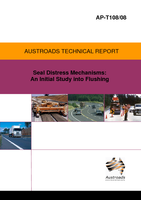Pavement

Seal Distress Mechanisms: An Initial Study into Flushing
- Publication no: AP-T108-08
- ISBN: 978-1-921329-81-4
- Published: 21 August 2008
- PDF (free) Download
A review of bleeding or flushed seals was undertaken to determine what physical changes had taken place within the seal that had resulted in the binder lying at or close to the surface. The evaluation process used a visual appraisal and a digital image process. A number of experienced personnel examined samples of seals taken from the road bed and asked to comment on the condition of the seal. The collated comments were compared to a digital analysis technique. The digital analysis technique applied algorithms to measure various areas within the seal and quantify a number of indicative parameters. This work was seen as a pilot study and further work looking at a broader range of seal types and distress levels was deemed necessary to validate the digital analysis process.
- AP-T108/08 SEAL DISTRESS MECHANISMS: AN INITIAL STUDY INTO FLUSHING
- 1. BACKGROUND
- 1.1. General
- 1.2. Possible Mechanisms
- 2. OVERVIEW OF THE METHOD
- 3. TESTING OF SAMPLES
- 3.1. Assumptions
- 3.2. Samples
- 3.3. Visual Assessment
- 3.4. Manual Assessment
- 3.5. Obtaining a Digital Image
- 3.6. Software Analysis Process
- 4. RESULTS OF VISUAL EXAMINATION
- 4.1. Sturt Highway Samples
- 4.2. Calder Highway Samples
- 5. MANUAL METHOD FINDINGS
- 5.1. Sturt Highway
- 5.2. Calder Highway
- 6. IMAGE ANALYSIS SOFTWARE FINDINGS
- 6.1. Sturt Highway Samples
- 6.2. Calder Highway Samples
- 7. CONCLUSIONS
- 8. RECOMMENDATIONS
Related publications
Latest Pavement News
